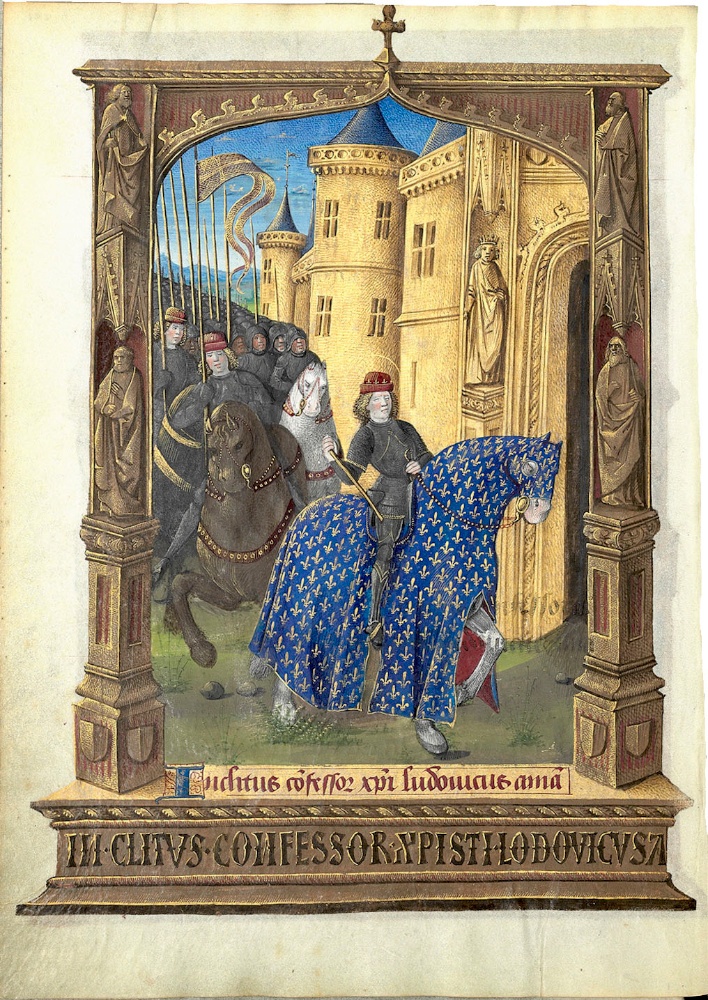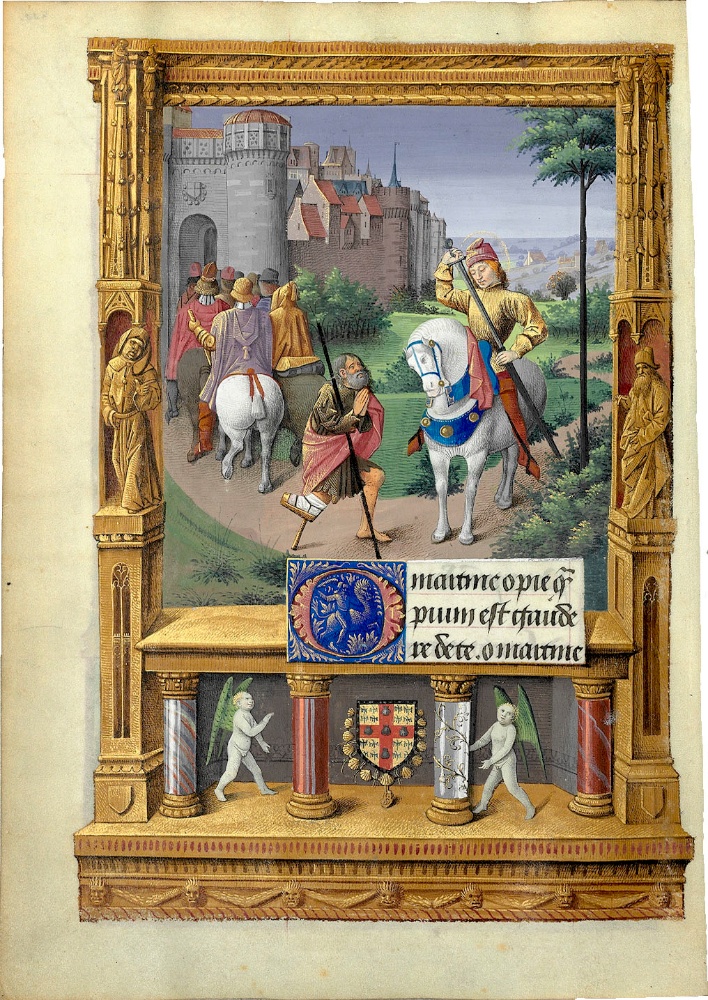The Book of Hours of Louis de Laval is an extraordinary example of XV Century French illumination: a result of the partnership between Jean Colombe and the workshop of Jean Fouquet.
Article by Christine Seidel, Freie Universität Berlin
There is no other book of hours of the 15th century that can compare with the rich biblical and devotional imagery in the Book of Hours of Louis de Laval (Paris, BnF, ms. lat. 920). Produced in the workshop of Jean Colombe, an illuminator active in Bourges between 1463 and 1493, this volume is a unique testimony to the art of illumination exercised in Bourges and the new technical inventions of the unsurpassed renovator of 15th century French painting, Jean Fouquet of Tours. The manuscript is bound in a precious red leather binding à la fanfare carrying the monogram of Henry IV, suitable for a book of an almost royal splendour.
1234 Images, 157 Full-Page Miniatures
The manuscript is adorned with 1234 images, of which 157 are painted as full-page miniatures and framed by monumental gilded architectural borders. Gold ground borders framing every text page enclose two different types of illustrative cycles in the lower and outer margins, which run across the entire manuscript. They unfold a rich depiction of the stories from the Old Testament, accompanied by explanative inscriptions in old French, which develop a cycle in its own right that has no direct connection to the text of the book of hours itself and does not relate to the cycle in the outer margin (which paraphrases the content of the book on various levels).
Calendar, Offices, Litanies and Other Devotions
The book of hours of Louis de Laval starts with a splendidly illuminated calendar, which includes depictions of the monthly occupations, the signs of the zodiac and prophets. This is followed by rather unusual full-page miniatures of the 12 sibyls, with their prophecies on the facing pages, as well as the gospel readings and the common prayers to the Virgin. The magnificent diptych representing the patron in prayer kneeling before the Virgin opens the Office of the Virgin.
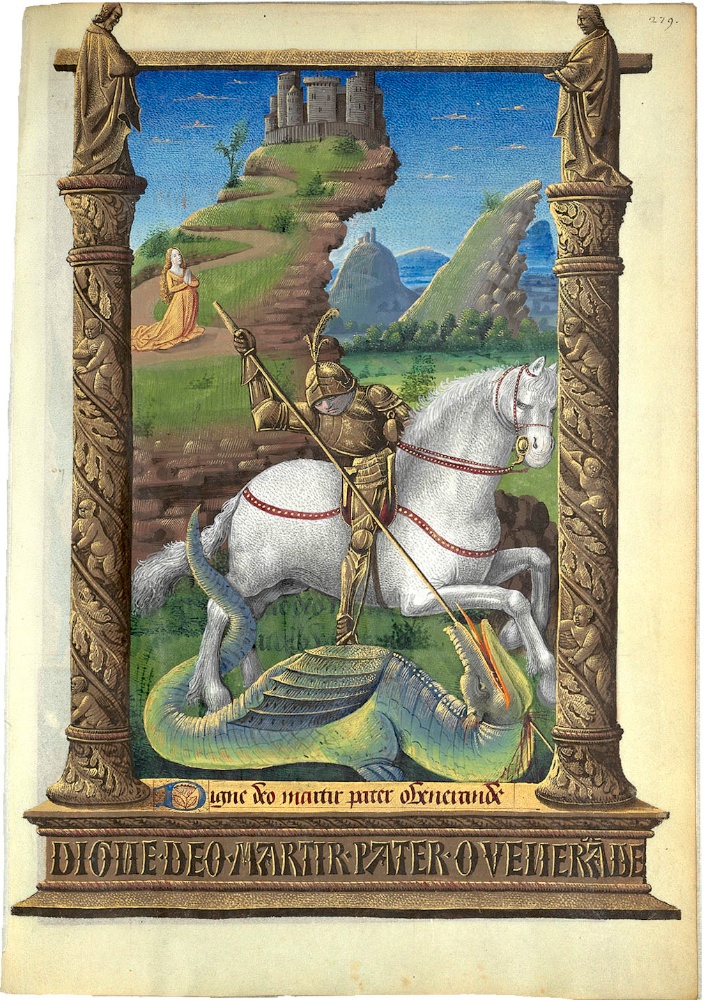
This richly illustrated Office contains the so-called “mixed hours,” which means that the Hours of the Holy Cross and the Hours of the Holy Spirit follow after each Hour of the Office of the Virgin beginning with Lauds instead of being arranged successively throughout the book. Then follow the Penitential Psalms and the Litany, which contain a series of full-page miniatures depicting the story of David and Bathsheba at the beginning of each psalm. Every section of the Litany is illustrated with a full-page representation of the venerated saints.
The Office of the Dead is introduced with a miniature for Vespers, and also contains an image for Matins. The sequence of 55 Suffrages is exceedingly rich, and illustrated with a full-page miniature for every saint. The book of hours of Louis de Laval terminates with the prayer Tu aimeras ton Seigneur, several indications for the life of a good Christian and a series of rare texts from the New Testament (including the letter of Saint Paul to the Corinthians, the 25th chapter of the Gospel of Saint Matthew [describing the Second Coming of Christ and thus the end of the world] and the Gospel of the Transfiguration, all translated into French).
Jean Colombe and the Master of the Yale Missal or Vienna Mamerot
An artist from the immediate cycle of Jean Fouquet worked together with Jean Colombe on the illumination of the book of hours. Specifically, this was the Master of the Vienna Mamerot, also called the Master of the Yale Missal, with whom Colombe collaborated several times around 1470. He was responsible for several full-page miniatures illustrating the sequence of suffrages of rather uncommon saints.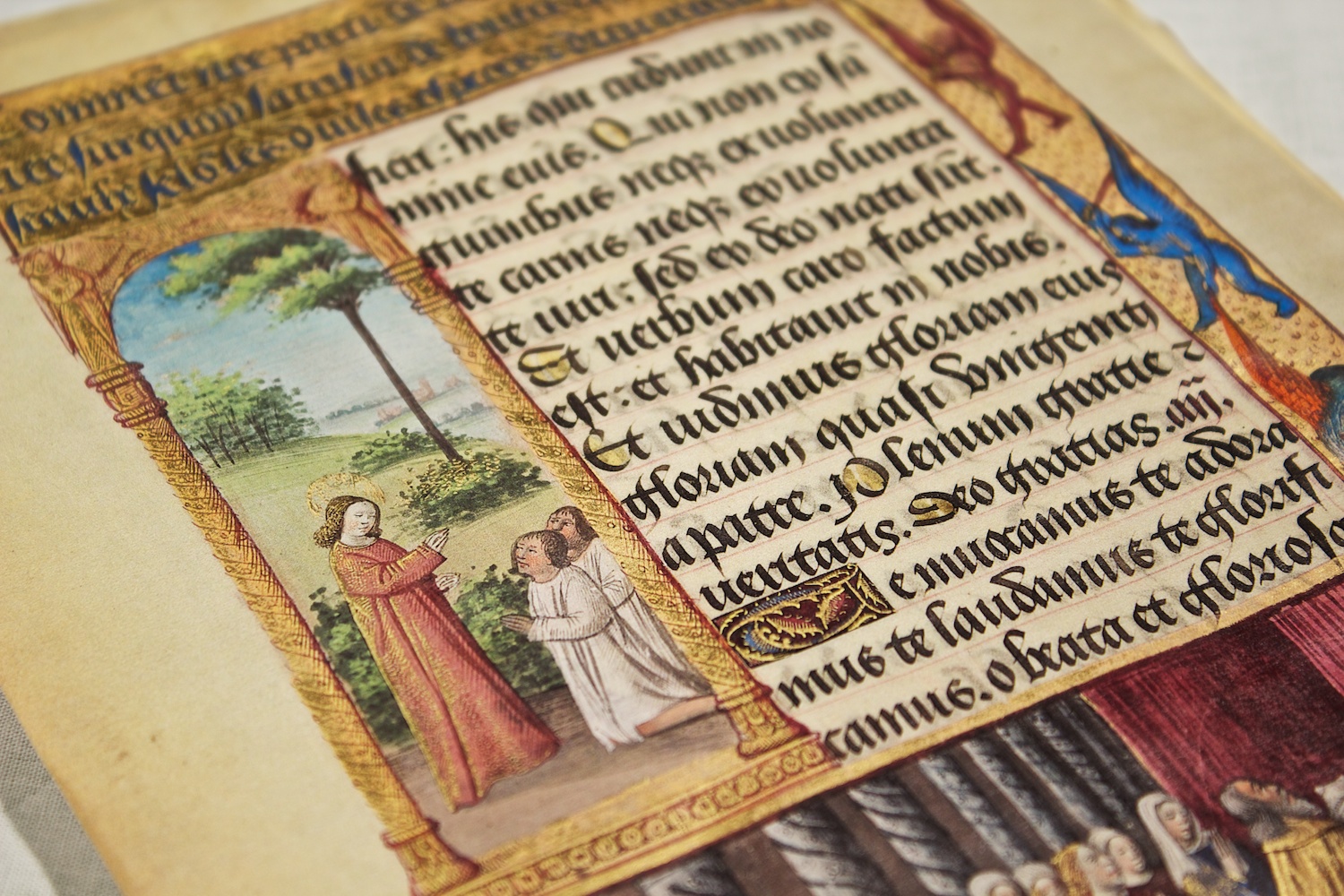
His participation and the coat of arms of the patron (which is supplemented with the collar of the Order of Saint Michael), together with the luminous and lively style of Jean Colombe (who had not yet found the monumentalised nervous and overstretched form of the later works) allows the dating of the beginning of the illumination campaign to around 1468. As François Avril has observed, a second campaign of decoration aimed at the insertion of the Old Testamentary cycle was very probably executed in Bourges about 10-15 years later, when the workshop of Jean Colombe comprised several assistants and collaborators (Cf. François Avril and Nicole Reynaud, Les manuscrits à peintures en France. 1440-1530, Paris, 1993, no. 179).
A Book Made for a Knight of the Order of Saint Michael
The manuscript was made for Louis de Laval, Seigneur de Châtillon, governor of Champagne since 1465 and Grand Master of the Forests and Waters of France since 1466. He came from a Breton noble family whose members fought together with the French king during the Hundred Years War. His older brothers were Guy XIV de Laval and André de Lohéac, who later became the governor of Paris and Marshall of France. Both were influential figures at the court, fought at Orléans together with Joan of Arc in 1428 and accompanied the king Charles VII during his campaign to Aquitaine against the English. The three brothers were among the first 15 knights to be accepted into the Order of Saint Michael, which was founded by Louis XI (the son of Charles VII) in 1469.
François Robertet, the secretary of Pierre of Beaujeu and Anne of France, left a note on the last folio (fol. 342v) of the book, giving the date of death of Louis de Laval (21 August 1489). Louis de Laval died at the age of 78 years and in 1489 his manuscript was inherited by the daughter of King Louis XI (Anne of Beaujeu, Duchess of Bourbon and of the Auvergne, who often resided in the Auvergne). The book of hours has remained in royal hands ever since. The daughter of King Louis XI also possessed a book of hours richly illuminated by the workshop of Jean Colombe (today at the Pierpont Morgan Library, M. 677). The manuscript adapts the conception of the book of hours of Louis de Laval and develops a new layout for the rich image cycles that were only successively added to the book of hours of Louis de Laval.

Discover this beautiful gem on Facsimile Finder
View galleryThe Idealised Resurrection of Louis de Laval on fol. 334 v.
Louis de Laval was buried in the collegiate church of Saint-Tugal at Laval, the funeral church of his family that was demolished in 1798. His book of hours testifies to this: On fol. 334v, the patron, depicted as a youthful man, kneels in front of his own tomb in the funeral chapel of Saint-Tugal, entirely decorated with the coat of arms of Laval-Châtillon. His effigy is painted in full colour, with hands folded in prayer and eyes open, and dressed in an armorial pourpoint. The white inscription that runs along the corners of the tomb slab reads: Ci repose Messire Loys de Laval Chevalier en son viven seigneur de [Chatillon] (to avoid the last confusion about the identity of the defunct).
Almost naked, but as a young man of impressive figure (muscular and intensely modelled with black colour and white highlights), Louis de Laval kneels in front of a demonstration of his mortality.
It is not the aged patron portrayed alive, but an idealised representation of his resurrected body that is praying to God depicted on the facing page.
Deep Inside the Manuscript
On fol. 335, which marks the beginning of the French translation of chapter 25 of the Gospel of Saint Matthew, Christ appears in majesty in the sky, sitting on a rainbow, his feet resting on an imperial globe. He is surrounded by a delicate aureole of golden rays, whilst the common symbol of his majesty used to demonstrate the glorification of the returning Son of God (the mandorla) is formed by the geometrical alignment of the angels arriving from the depth of the image. They surround the apparition and carry the instruments of the passion, while four angels descend with trumpets and close the almond-shaped form at the bottom. The Son of God appears above the fractured ground where the souls of men resurge, awaited by Saint Michael, who will divide the sinners from the redeemed.
The youthful figure of the patron contrasts strongly with a second image of Louis de Laval introducing the Office of the Virgin. There, he kneels in front of his prie-dieu praying to the Virgin with Child, who is surrounded by rows of angels. This diptych (fol. 50v-51) is inserted as a bifolio before the Office of the Virgin. In addition, fol. 50 is decorated with a full-page depiction of the coat of arms of Louis de Laval, whereas fol. 51v shows a depiction of God seated between Mercy and Justice, an allusion to the Meditations on the Life of Christ, which open with the debate on the redemption of men through the incarnation of the Son. As the advocates of men, Mercy and Justice intercede before God.
The diptych showing the owner of the book of hours before the Virgin goes back to the innovations introduced by Jean Fouquet of Tours. In the book of hours of Etienne Chevalier Chantilly, Musée Condé) — the important model for the hours of Louis de Laval — Jean Fouquet had created two corresponding full-page miniatures that showed the treasurer of France and counsellor of King Charles VII kneeling before the Virgin in a celestial court. This representation initially opened the Office of the Virgin, and this conception was also adapted for the book of hours of Louis de Laval. In addition, the representation of the patron aspires to the air of Touronese art: the face of Louis de Laval was painted by an artist from the immediate circle of Jean Fouquet, it revives the man depicted in prayer and can be understood as a real eternalised portrait of the owner.
A comparable method of partition of work is found constantly throughout the entire manuscript. Specialised artists reworked the faces of the Virgin and other central figures in almost all of the full-page miniatures.
This division of work was planned from the beginning and makes the book of hours of Louis de Laval a gigantic project of decoration for the 15th century.
A Unique Encounter with Berrichon Tradition and the Novel Art of Jean Fouquet.
The appearance of the book of hours of Louis de Laval is the result of several stages of execution leading to a unique richness of illumination. In the beginning, the book was conceived as a work partitioned between an illuminator in charge of the conception of the miniatures (who prepared the compositions and the overall layout of the manuscript) and specialised painters who were called in to finish the faces of the most important figures in the full-page miniatures.
As François Avril has observed, a reasonable approach to the refined painting technique could only be made with the Touronese workshop from the immediate circle of Jean Fouquet (cf. Les manuscrits à peintures, ut supra). The book of hours of Louis de Laval is the only known manuscript for which such an extended partition of work was planned, and it certainly reflects the grand appreciation that contemporaries had for the novel art of Jean Fouquet, which has strongly influenced the conception of the book of hours of Louis de Laval. From a structural point of view it can be understood as the first independent adaptation of Fouquet’s chief work, the Hours of Etienne Chevalier — not only because it repeats certain particularities of the sequence of texts and their divisions on the basis of the now commonly accepted reconstruction of the Chevalier manuscript, but also because it reflects several compositional inventions in the full-page miniatures, most apparent in the sequence created for the Office of the Virgin.
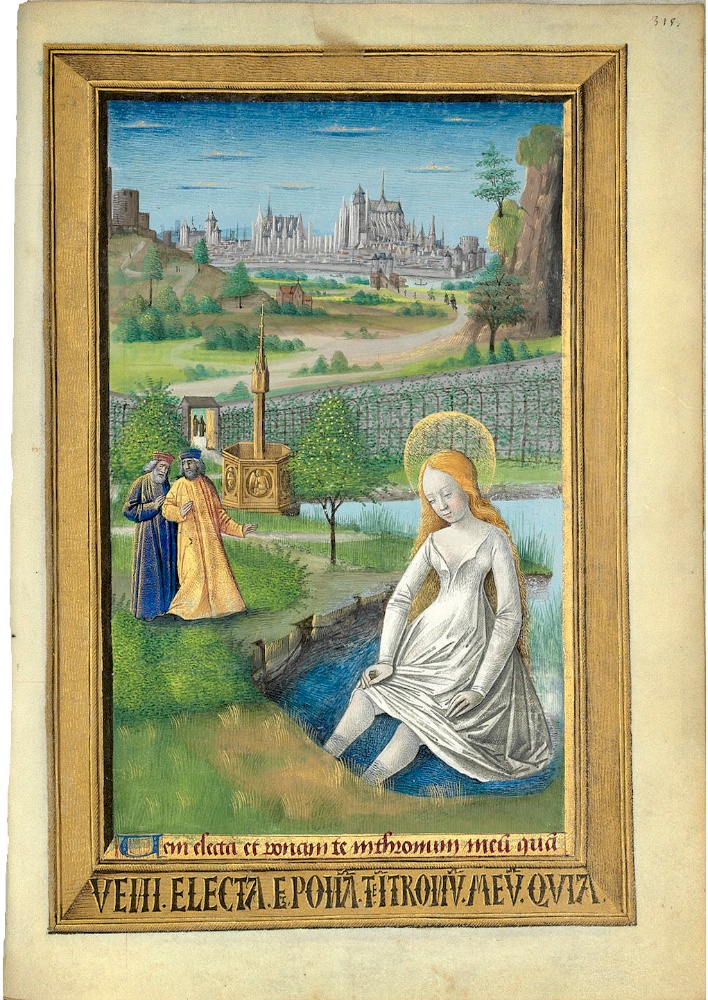
Louis the Laval — who was very close to Charles VII and, after the dispute with his son Louis, followed the dauphin Louis to the Dauphine — certainly knew the treasurer of France during the time of Charles VII, and probably also his book of hours, which was illuminated by the royal painter Jean Fouquet. He probably also knew the Varie family of Bourges, which also rose to power during the reign of Charles VII. The addition in the book of hours of Simon de Varie (The Haugue, Koninklijke bibliotheek and Los Angeles, J. Paul Getty Museum) made by Jean Fouquet probably gives the best impression of the qualities that the contemporaries already must have admired. The Dunois Master and the Master of Jean Rolin II illuminated the small manuscript in Paris in the 1450s. Since the court travelled between the different castles at the Loire border, Simon de Varie chose to have his book of hours embellished by the court painter Jean Fouquet.
He not only inserted full-page miniatures (the most important being the diptych of the patron kneeling before the Virgin with two heraldic depictions on the outer folios — a system which is repeated in the book of hours of Louis de Laval), but also repainted almost all the faces of the Virgin and most of the faces of the Christ child painted by the Dunois Master. This idea of animation also governs the conception of the book of hours of Louis de Laval, which was embellished with the help of Touronese artists working on the miniatures prepared by Jean Colombe.
Whereas the compositions for the Hours of the Holy Cross refer to traditional motives for the sequence of events of the Passion, the miniatures of the Office of the Virgin put a strong focus on the life of the Virgin and largely refer to compositions by Jean Fouquet that depict rather unusual scenes at the time. Jean Colombe, who was certainly not a disciple of Jean Fouquet, but rather a very receptive contemporary of the court painter who was also working for kings and queens, developed a unique richness of images in the book of hours of Louis de Laval that surpassed the sources of Fouquet’s art by submerging the text in an inventive and untamed imagery throughout the entire manuscript.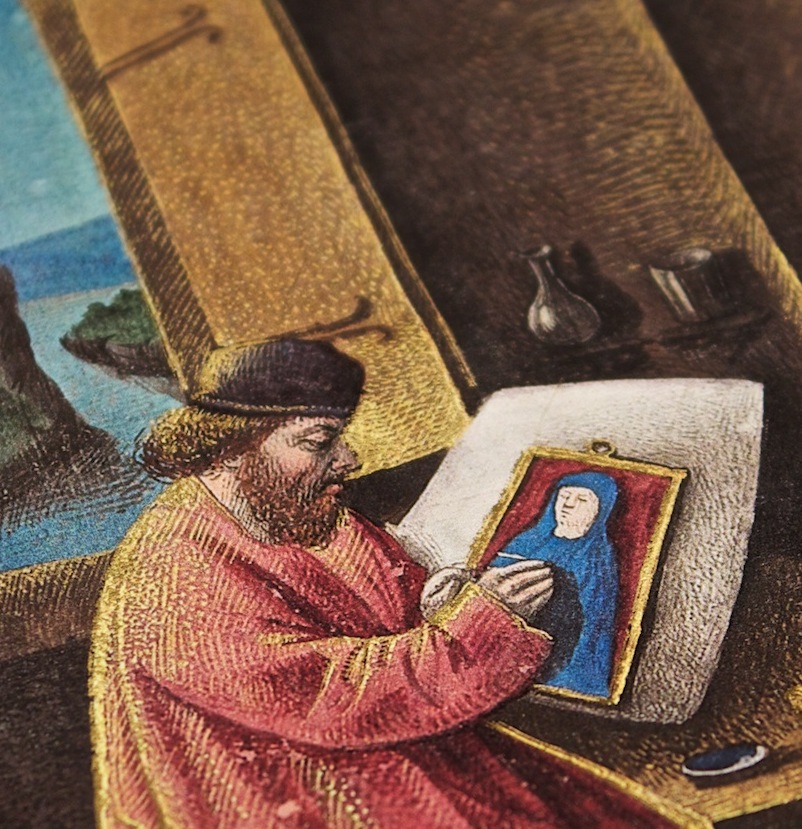
A Mirror of Human Salvation
When opening a common book of hours, one does not expect to perceive an image of the creation of the world in the beginning. Comparable biblical cycles are limited to large Bible illustrations, as one finds them in Naples in the 14th century, for example. However, it certainly exceeds the traditional world of images in books of hours. A full-page representation of God as the Creator opens the Book of Hours of Louis de Laval on fol. 2v and thus the cycle with scenes from the Old Testament from Genesis to the Book of Daniel. This cycle was added in a later campaign and testifies the horror vacui typical for the manuscripts illuminated in Colombe’s workshop. The parallel lecture of the devotional texts and the images of the Old Testament, accompanied by explicative inscriptions, connects with a typological tradition introduced by the Sybelline prophecies, the prophetesses of Antiquity (cf. Claude Schaefer, ‘Nouvelles observations sur le sujet des Heures de Laval’, 1980).
The Book of Hours of Louis de Laval is a veritable masterpiece of illumination between the end of the Middle Ages and the beginning of Renaissance art.
It is unique in its richness of illumination, which represents different stages of execution that unite the illustrated beginnings of the texts, the text pages accompanied by an illustrative cycle and finally a “picture bible” depicting scenes from Genesis to the Book of Daniel. The work was executed in the workshop of Jean Colombe in Bourges, with the help of close followers of Jean Fouquet from Tours. With its exceedingly rich imagery of biblical iconography, it is one outstanding sum of the possibilities and achievements of French manuscript illumination in the second half of the 15th century.

Hours of Louis de Laval, facsimile edition
Find this unparalleled illuminated manuscript in a facsimile edition on Facsimile Finder
Read more

